BBS205 - HR Processes for Vegemite Delight Restaurant Expansion
VerifiedAdded on 2022/11/11
|11
|2655
|213
Case Study
AI Summary
This case study examines the HR processes required for the expansion of Vegemite Delight, a restaurant chain in Melbourne, as it opens two new locations. The analysis covers essential HR functions such as human resource planning, employee selection, recruitment, hiring, training, orientation, remuneration and benefits, employee relations, performance management, and exit processes. It emphasizes the importance of these processes in ensuring smooth operations, positive work culture, and effective employee management within the organization. The study highlights the critical role of HR in transforming recruits into valuable company assets, designing competitive remuneration policies, and fostering a healthy work environment to maintain stability and brand value in the hospitality industry.
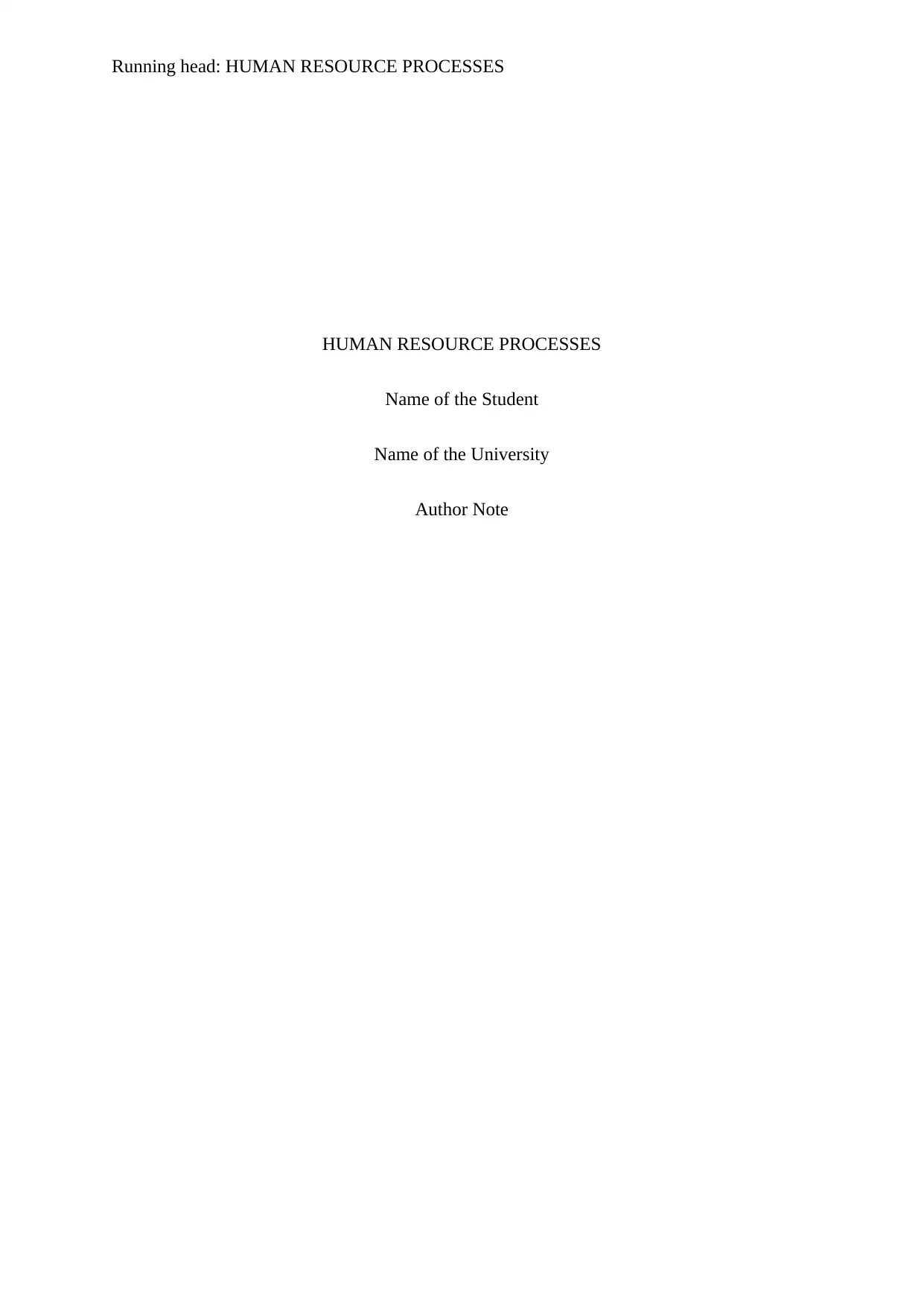
Running head: HUMAN RESOURCE PROCESSES
HUMAN RESOURCE PROCESSES
Name of the Student
Name of the University
Author Note
HUMAN RESOURCE PROCESSES
Name of the Student
Name of the University
Author Note
Paraphrase This Document
Need a fresh take? Get an instant paraphrase of this document with our AI Paraphraser
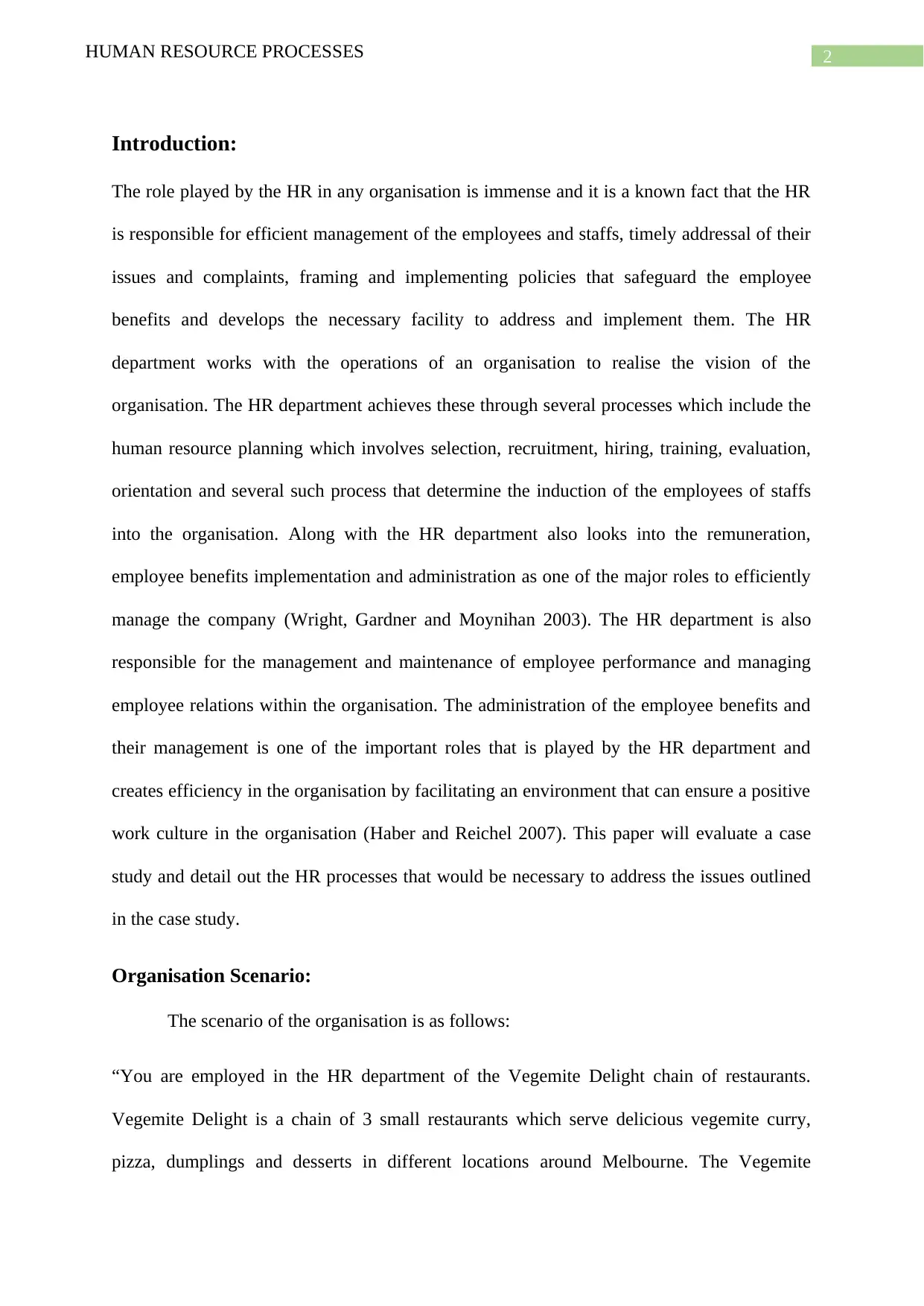
2HUMAN RESOURCE PROCESSES
Introduction:
The role played by the HR in any organisation is immense and it is a known fact that the HR
is responsible for efficient management of the employees and staffs, timely addressal of their
issues and complaints, framing and implementing policies that safeguard the employee
benefits and develops the necessary facility to address and implement them. The HR
department works with the operations of an organisation to realise the vision of the
organisation. The HR department achieves these through several processes which include the
human resource planning which involves selection, recruitment, hiring, training, evaluation,
orientation and several such process that determine the induction of the employees of staffs
into the organisation. Along with the HR department also looks into the remuneration,
employee benefits implementation and administration as one of the major roles to efficiently
manage the company (Wright, Gardner and Moynihan 2003). The HR department is also
responsible for the management and maintenance of employee performance and managing
employee relations within the organisation. The administration of the employee benefits and
their management is one of the important roles that is played by the HR department and
creates efficiency in the organisation by facilitating an environment that can ensure a positive
work culture in the organisation (Haber and Reichel 2007). This paper will evaluate a case
study and detail out the HR processes that would be necessary to address the issues outlined
in the case study.
Organisation Scenario:
The scenario of the organisation is as follows:
“You are employed in the HR department of the Vegemite Delight chain of restaurants.
Vegemite Delight is a chain of 3 small restaurants which serve delicious vegemite curry,
pizza, dumplings and desserts in different locations around Melbourne. The Vegemite
Introduction:
The role played by the HR in any organisation is immense and it is a known fact that the HR
is responsible for efficient management of the employees and staffs, timely addressal of their
issues and complaints, framing and implementing policies that safeguard the employee
benefits and develops the necessary facility to address and implement them. The HR
department works with the operations of an organisation to realise the vision of the
organisation. The HR department achieves these through several processes which include the
human resource planning which involves selection, recruitment, hiring, training, evaluation,
orientation and several such process that determine the induction of the employees of staffs
into the organisation. Along with the HR department also looks into the remuneration,
employee benefits implementation and administration as one of the major roles to efficiently
manage the company (Wright, Gardner and Moynihan 2003). The HR department is also
responsible for the management and maintenance of employee performance and managing
employee relations within the organisation. The administration of the employee benefits and
their management is one of the important roles that is played by the HR department and
creates efficiency in the organisation by facilitating an environment that can ensure a positive
work culture in the organisation (Haber and Reichel 2007). This paper will evaluate a case
study and detail out the HR processes that would be necessary to address the issues outlined
in the case study.
Organisation Scenario:
The scenario of the organisation is as follows:
“You are employed in the HR department of the Vegemite Delight chain of restaurants.
Vegemite Delight is a chain of 3 small restaurants which serve delicious vegemite curry,
pizza, dumplings and desserts in different locations around Melbourne. The Vegemite
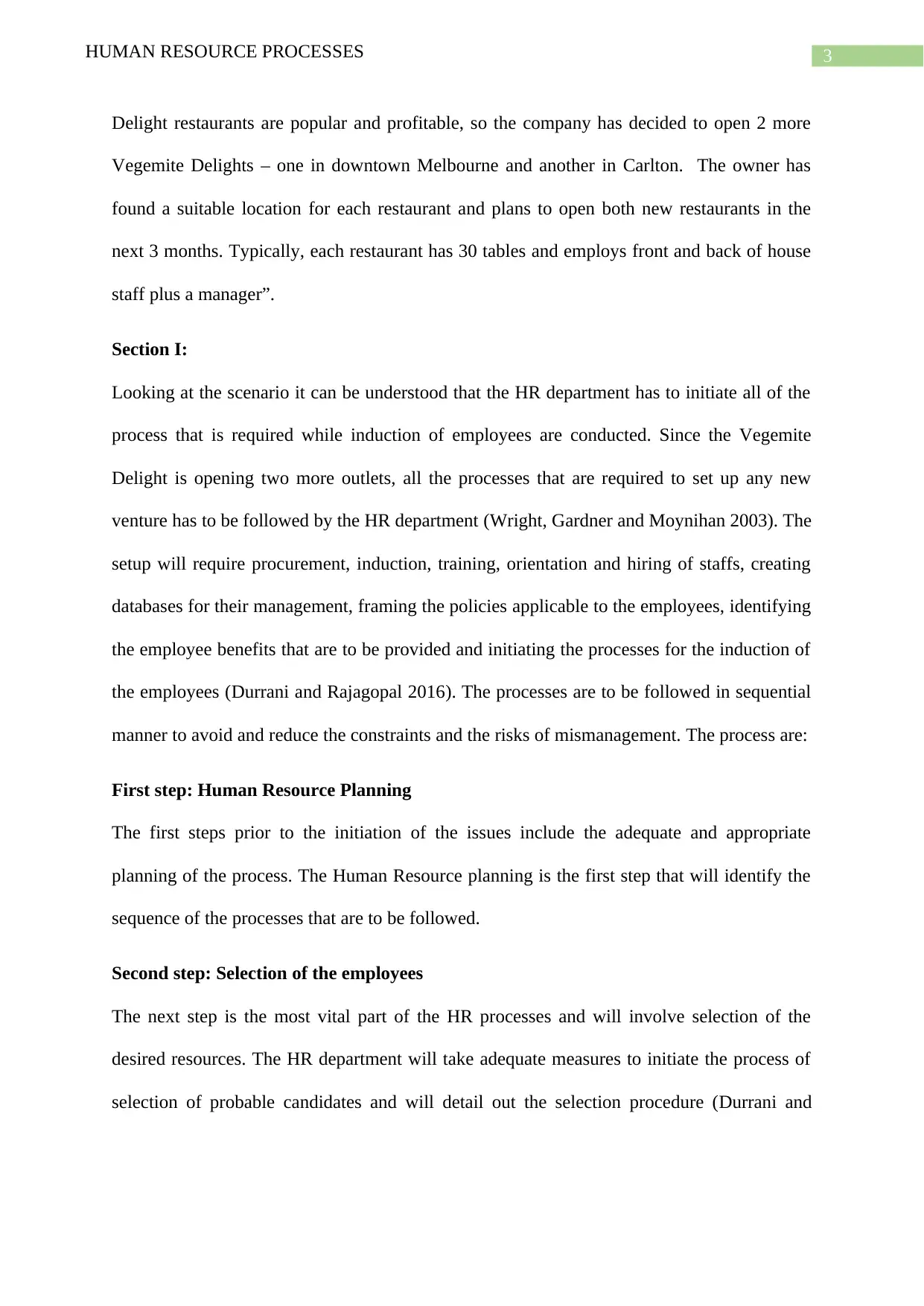
3HUMAN RESOURCE PROCESSES
Delight restaurants are popular and profitable, so the company has decided to open 2 more
Vegemite Delights – one in downtown Melbourne and another in Carlton. The owner has
found a suitable location for each restaurant and plans to open both new restaurants in the
next 3 months. Typically, each restaurant has 30 tables and employs front and back of house
staff plus a manager”.
Section I:
Looking at the scenario it can be understood that the HR department has to initiate all of the
process that is required while induction of employees are conducted. Since the Vegemite
Delight is opening two more outlets, all the processes that are required to set up any new
venture has to be followed by the HR department (Wright, Gardner and Moynihan 2003). The
setup will require procurement, induction, training, orientation and hiring of staffs, creating
databases for their management, framing the policies applicable to the employees, identifying
the employee benefits that are to be provided and initiating the processes for the induction of
the employees (Durrani and Rajagopal 2016). The processes are to be followed in sequential
manner to avoid and reduce the constraints and the risks of mismanagement. The process are:
First step: Human Resource Planning
The first steps prior to the initiation of the issues include the adequate and appropriate
planning of the process. The Human Resource planning is the first step that will identify the
sequence of the processes that are to be followed.
Second step: Selection of the employees
The next step is the most vital part of the HR processes and will involve selection of the
desired resources. The HR department will take adequate measures to initiate the process of
selection of probable candidates and will detail out the selection procedure (Durrani and
Delight restaurants are popular and profitable, so the company has decided to open 2 more
Vegemite Delights – one in downtown Melbourne and another in Carlton. The owner has
found a suitable location for each restaurant and plans to open both new restaurants in the
next 3 months. Typically, each restaurant has 30 tables and employs front and back of house
staff plus a manager”.
Section I:
Looking at the scenario it can be understood that the HR department has to initiate all of the
process that is required while induction of employees are conducted. Since the Vegemite
Delight is opening two more outlets, all the processes that are required to set up any new
venture has to be followed by the HR department (Wright, Gardner and Moynihan 2003). The
setup will require procurement, induction, training, orientation and hiring of staffs, creating
databases for their management, framing the policies applicable to the employees, identifying
the employee benefits that are to be provided and initiating the processes for the induction of
the employees (Durrani and Rajagopal 2016). The processes are to be followed in sequential
manner to avoid and reduce the constraints and the risks of mismanagement. The process are:
First step: Human Resource Planning
The first steps prior to the initiation of the issues include the adequate and appropriate
planning of the process. The Human Resource planning is the first step that will identify the
sequence of the processes that are to be followed.
Second step: Selection of the employees
The next step is the most vital part of the HR processes and will involve selection of the
desired resources. The HR department will take adequate measures to initiate the process of
selection of probable candidates and will detail out the selection procedure (Durrani and
⊘ This is a preview!⊘
Do you want full access?
Subscribe today to unlock all pages.

Trusted by 1+ million students worldwide
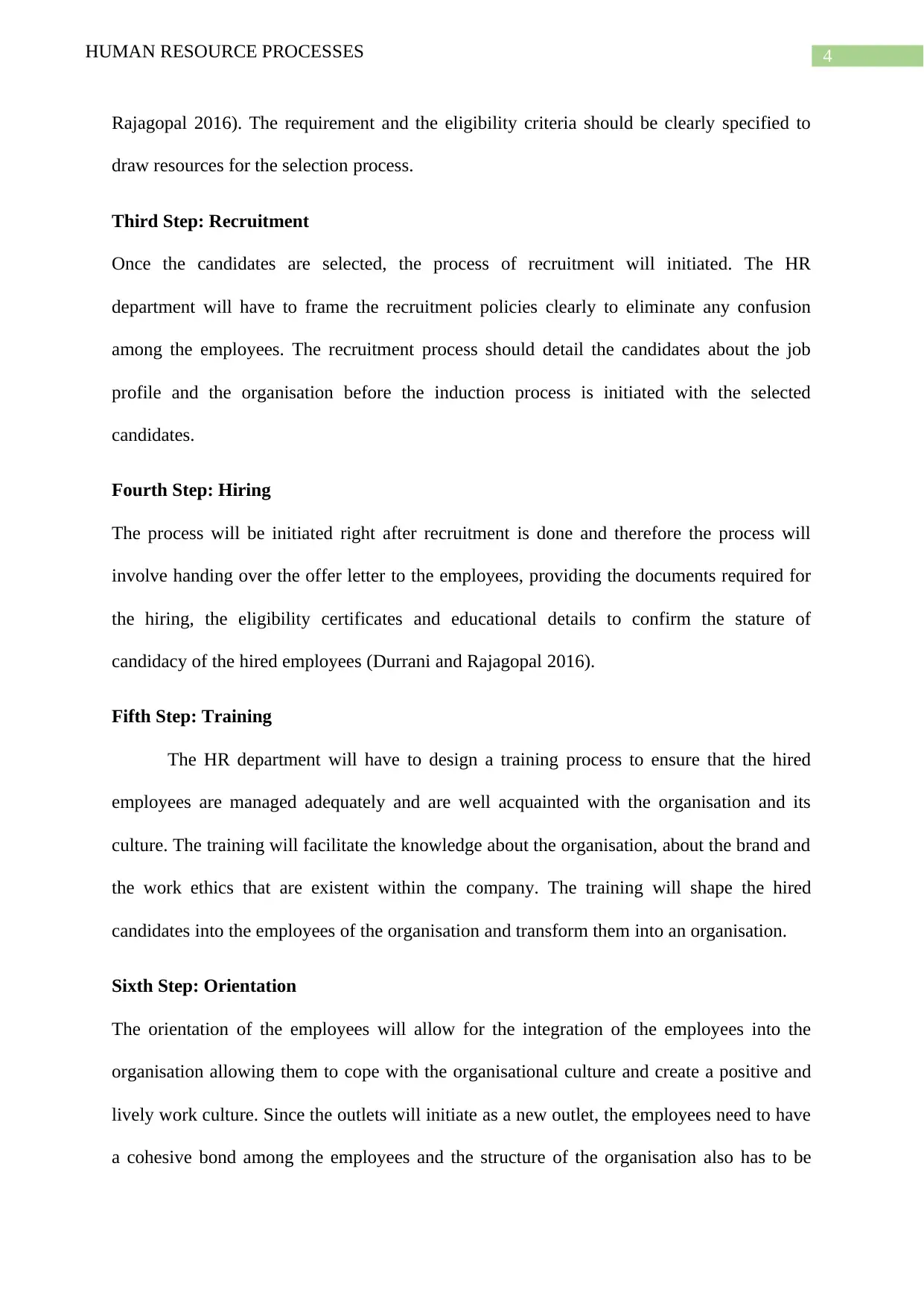
4HUMAN RESOURCE PROCESSES
Rajagopal 2016). The requirement and the eligibility criteria should be clearly specified to
draw resources for the selection process.
Third Step: Recruitment
Once the candidates are selected, the process of recruitment will initiated. The HR
department will have to frame the recruitment policies clearly to eliminate any confusion
among the employees. The recruitment process should detail the candidates about the job
profile and the organisation before the induction process is initiated with the selected
candidates.
Fourth Step: Hiring
The process will be initiated right after recruitment is done and therefore the process will
involve handing over the offer letter to the employees, providing the documents required for
the hiring, the eligibility certificates and educational details to confirm the stature of
candidacy of the hired employees (Durrani and Rajagopal 2016).
Fifth Step: Training
The HR department will have to design a training process to ensure that the hired
employees are managed adequately and are well acquainted with the organisation and its
culture. The training will facilitate the knowledge about the organisation, about the brand and
the work ethics that are existent within the company. The training will shape the hired
candidates into the employees of the organisation and transform them into an organisation.
Sixth Step: Orientation
The orientation of the employees will allow for the integration of the employees into the
organisation allowing them to cope with the organisational culture and create a positive and
lively work culture. Since the outlets will initiate as a new outlet, the employees need to have
a cohesive bond among the employees and the structure of the organisation also has to be
Rajagopal 2016). The requirement and the eligibility criteria should be clearly specified to
draw resources for the selection process.
Third Step: Recruitment
Once the candidates are selected, the process of recruitment will initiated. The HR
department will have to frame the recruitment policies clearly to eliminate any confusion
among the employees. The recruitment process should detail the candidates about the job
profile and the organisation before the induction process is initiated with the selected
candidates.
Fourth Step: Hiring
The process will be initiated right after recruitment is done and therefore the process will
involve handing over the offer letter to the employees, providing the documents required for
the hiring, the eligibility certificates and educational details to confirm the stature of
candidacy of the hired employees (Durrani and Rajagopal 2016).
Fifth Step: Training
The HR department will have to design a training process to ensure that the hired
employees are managed adequately and are well acquainted with the organisation and its
culture. The training will facilitate the knowledge about the organisation, about the brand and
the work ethics that are existent within the company. The training will shape the hired
candidates into the employees of the organisation and transform them into an organisation.
Sixth Step: Orientation
The orientation of the employees will allow for the integration of the employees into the
organisation allowing them to cope with the organisational culture and create a positive and
lively work culture. Since the outlets will initiate as a new outlet, the employees need to have
a cohesive bond among the employees and the structure of the organisation also has to be
Paraphrase This Document
Need a fresh take? Get an instant paraphrase of this document with our AI Paraphraser
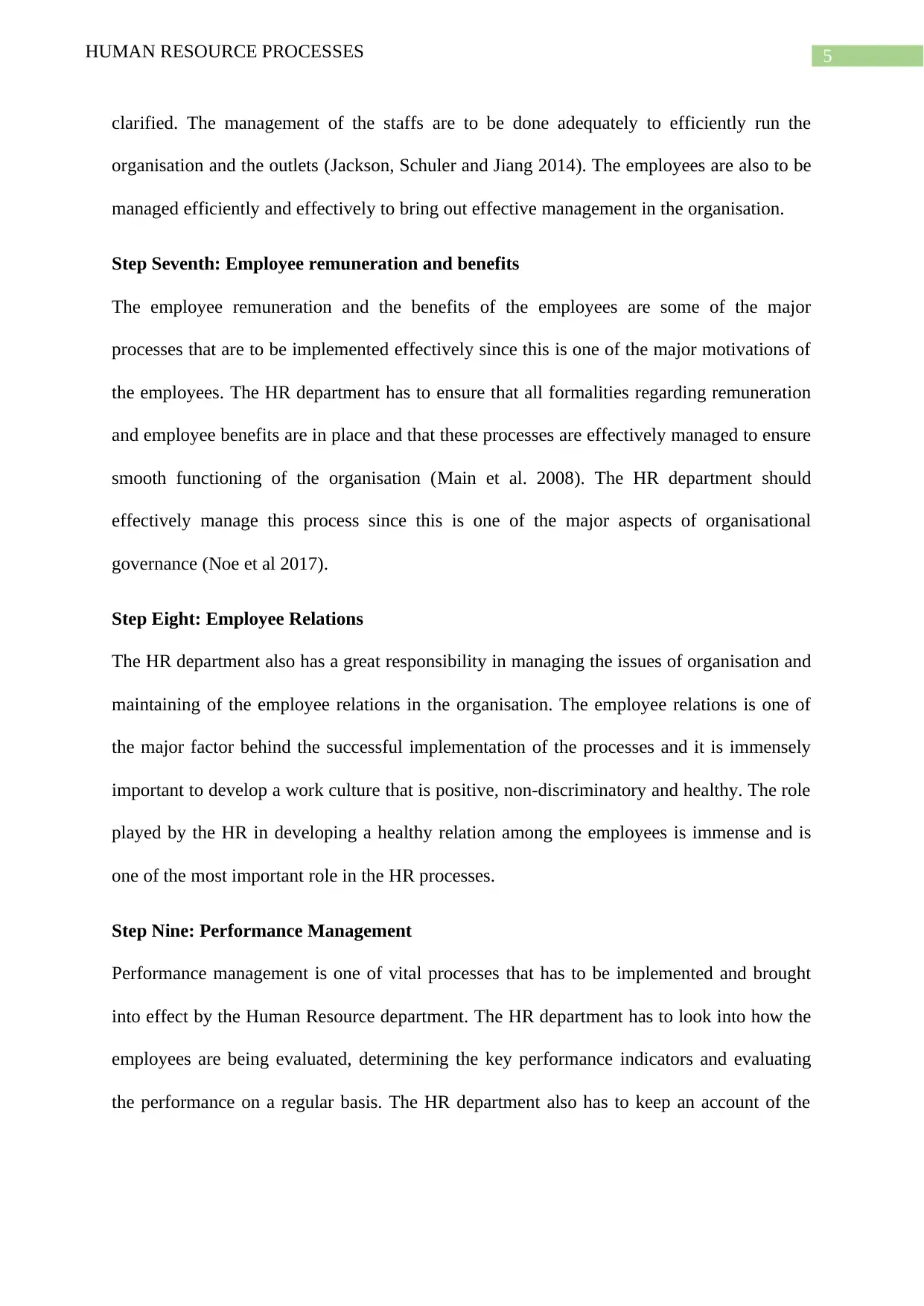
5HUMAN RESOURCE PROCESSES
clarified. The management of the staffs are to be done adequately to efficiently run the
organisation and the outlets (Jackson, Schuler and Jiang 2014). The employees are also to be
managed efficiently and effectively to bring out effective management in the organisation.
Step Seventh: Employee remuneration and benefits
The employee remuneration and the benefits of the employees are some of the major
processes that are to be implemented effectively since this is one of the major motivations of
the employees. The HR department has to ensure that all formalities regarding remuneration
and employee benefits are in place and that these processes are effectively managed to ensure
smooth functioning of the organisation (Main et al. 2008). The HR department should
effectively manage this process since this is one of the major aspects of organisational
governance (Noe et al 2017).
Step Eight: Employee Relations
The HR department also has a great responsibility in managing the issues of organisation and
maintaining of the employee relations in the organisation. The employee relations is one of
the major factor behind the successful implementation of the processes and it is immensely
important to develop a work culture that is positive, non-discriminatory and healthy. The role
played by the HR in developing a healthy relation among the employees is immense and is
one of the most important role in the HR processes.
Step Nine: Performance Management
Performance management is one of vital processes that has to be implemented and brought
into effect by the Human Resource department. The HR department has to look into how the
employees are being evaluated, determining the key performance indicators and evaluating
the performance on a regular basis. The HR department also has to keep an account of the
clarified. The management of the staffs are to be done adequately to efficiently run the
organisation and the outlets (Jackson, Schuler and Jiang 2014). The employees are also to be
managed efficiently and effectively to bring out effective management in the organisation.
Step Seventh: Employee remuneration and benefits
The employee remuneration and the benefits of the employees are some of the major
processes that are to be implemented effectively since this is one of the major motivations of
the employees. The HR department has to ensure that all formalities regarding remuneration
and employee benefits are in place and that these processes are effectively managed to ensure
smooth functioning of the organisation (Main et al. 2008). The HR department should
effectively manage this process since this is one of the major aspects of organisational
governance (Noe et al 2017).
Step Eight: Employee Relations
The HR department also has a great responsibility in managing the issues of organisation and
maintaining of the employee relations in the organisation. The employee relations is one of
the major factor behind the successful implementation of the processes and it is immensely
important to develop a work culture that is positive, non-discriminatory and healthy. The role
played by the HR in developing a healthy relation among the employees is immense and is
one of the most important role in the HR processes.
Step Nine: Performance Management
Performance management is one of vital processes that has to be implemented and brought
into effect by the Human Resource department. The HR department has to look into how the
employees are being evaluated, determining the key performance indicators and evaluating
the performance on a regular basis. The HR department also has to keep an account of the
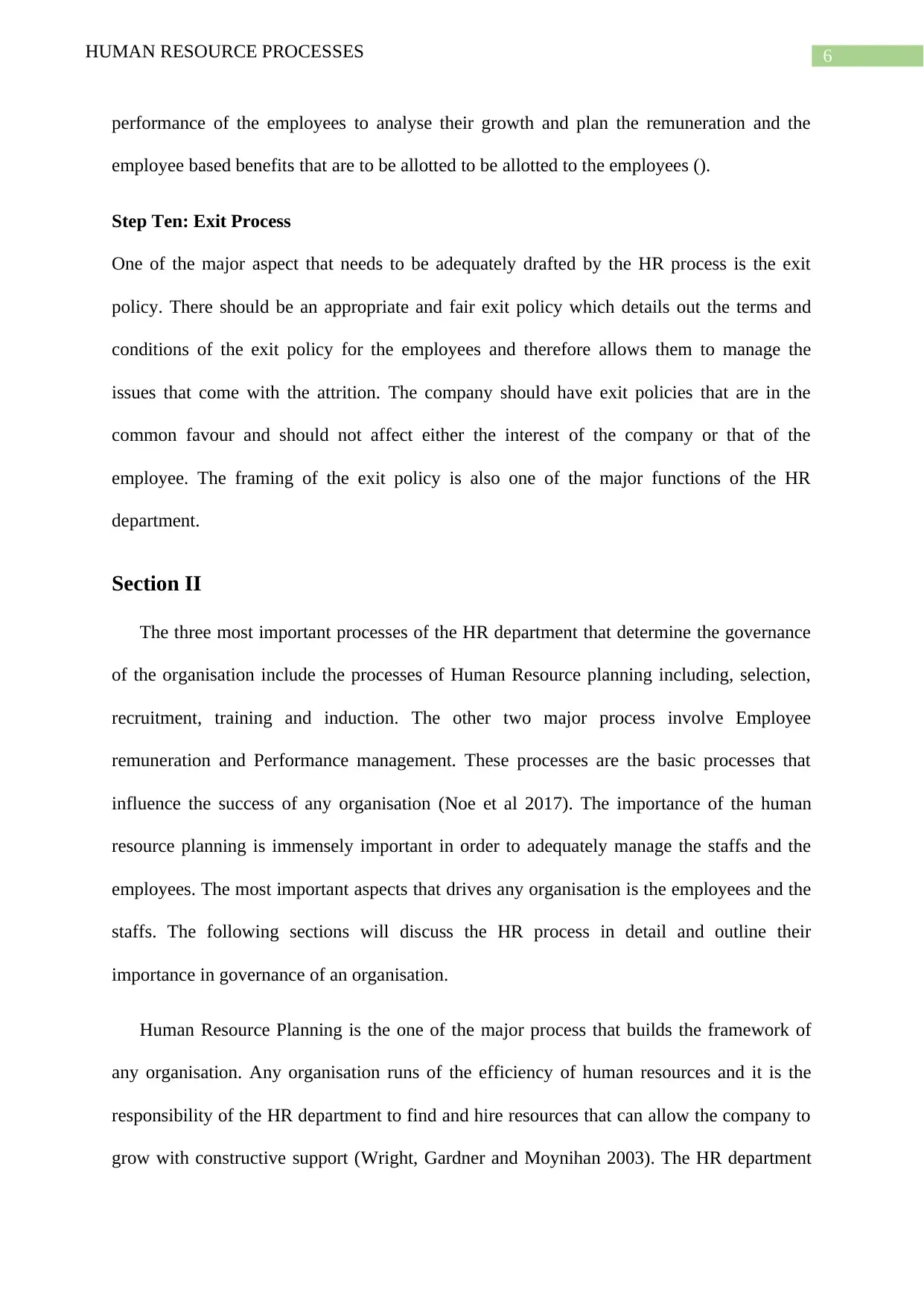
6HUMAN RESOURCE PROCESSES
performance of the employees to analyse their growth and plan the remuneration and the
employee based benefits that are to be allotted to be allotted to the employees ().
Step Ten: Exit Process
One of the major aspect that needs to be adequately drafted by the HR process is the exit
policy. There should be an appropriate and fair exit policy which details out the terms and
conditions of the exit policy for the employees and therefore allows them to manage the
issues that come with the attrition. The company should have exit policies that are in the
common favour and should not affect either the interest of the company or that of the
employee. The framing of the exit policy is also one of the major functions of the HR
department.
Section II
The three most important processes of the HR department that determine the governance
of the organisation include the processes of Human Resource planning including, selection,
recruitment, training and induction. The other two major process involve Employee
remuneration and Performance management. These processes are the basic processes that
influence the success of any organisation (Noe et al 2017). The importance of the human
resource planning is immensely important in order to adequately manage the staffs and the
employees. The most important aspects that drives any organisation is the employees and the
staffs. The following sections will discuss the HR process in detail and outline their
importance in governance of an organisation.
Human Resource Planning is the one of the major process that builds the framework of
any organisation. Any organisation runs of the efficiency of human resources and it is the
responsibility of the HR department to find and hire resources that can allow the company to
grow with constructive support (Wright, Gardner and Moynihan 2003). The HR department
performance of the employees to analyse their growth and plan the remuneration and the
employee based benefits that are to be allotted to be allotted to the employees ().
Step Ten: Exit Process
One of the major aspect that needs to be adequately drafted by the HR process is the exit
policy. There should be an appropriate and fair exit policy which details out the terms and
conditions of the exit policy for the employees and therefore allows them to manage the
issues that come with the attrition. The company should have exit policies that are in the
common favour and should not affect either the interest of the company or that of the
employee. The framing of the exit policy is also one of the major functions of the HR
department.
Section II
The three most important processes of the HR department that determine the governance
of the organisation include the processes of Human Resource planning including, selection,
recruitment, training and induction. The other two major process involve Employee
remuneration and Performance management. These processes are the basic processes that
influence the success of any organisation (Noe et al 2017). The importance of the human
resource planning is immensely important in order to adequately manage the staffs and the
employees. The most important aspects that drives any organisation is the employees and the
staffs. The following sections will discuss the HR process in detail and outline their
importance in governance of an organisation.
Human Resource Planning is the one of the major process that builds the framework of
any organisation. Any organisation runs of the efficiency of human resources and it is the
responsibility of the HR department to find and hire resources that can allow the company to
grow with constructive support (Wright, Gardner and Moynihan 2003). The HR department
⊘ This is a preview!⊘
Do you want full access?
Subscribe today to unlock all pages.

Trusted by 1+ million students worldwide
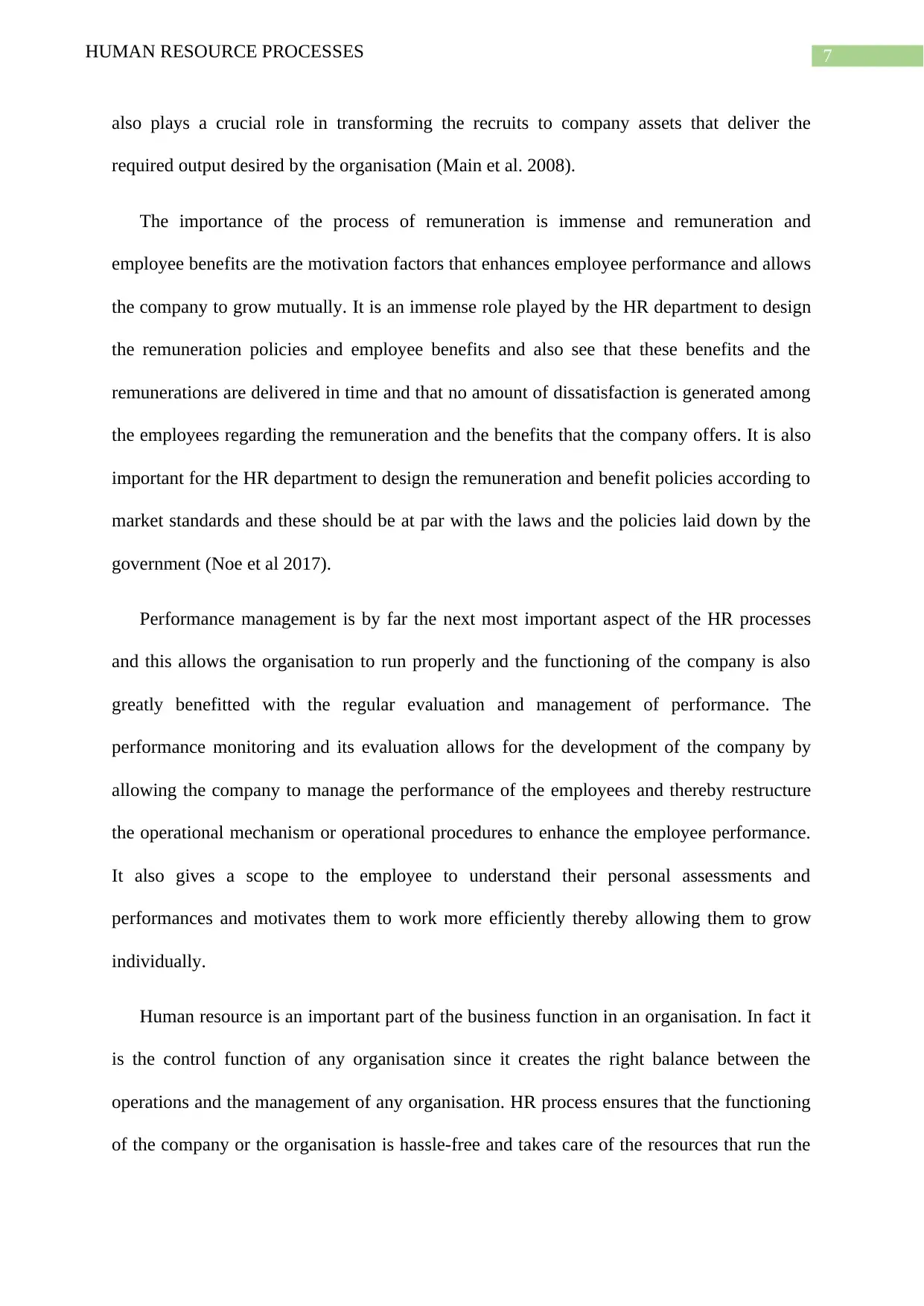
7HUMAN RESOURCE PROCESSES
also plays a crucial role in transforming the recruits to company assets that deliver the
required output desired by the organisation (Main et al. 2008).
The importance of the process of remuneration is immense and remuneration and
employee benefits are the motivation factors that enhances employee performance and allows
the company to grow mutually. It is an immense role played by the HR department to design
the remuneration policies and employee benefits and also see that these benefits and the
remunerations are delivered in time and that no amount of dissatisfaction is generated among
the employees regarding the remuneration and the benefits that the company offers. It is also
important for the HR department to design the remuneration and benefit policies according to
market standards and these should be at par with the laws and the policies laid down by the
government (Noe et al 2017).
Performance management is by far the next most important aspect of the HR processes
and this allows the organisation to run properly and the functioning of the company is also
greatly benefitted with the regular evaluation and management of performance. The
performance monitoring and its evaluation allows for the development of the company by
allowing the company to manage the performance of the employees and thereby restructure
the operational mechanism or operational procedures to enhance the employee performance.
It also gives a scope to the employee to understand their personal assessments and
performances and motivates them to work more efficiently thereby allowing them to grow
individually.
Human resource is an important part of the business function in an organisation. In fact it
is the control function of any organisation since it creates the right balance between the
operations and the management of any organisation. HR process ensures that the functioning
of the company or the organisation is hassle-free and takes care of the resources that run the
also plays a crucial role in transforming the recruits to company assets that deliver the
required output desired by the organisation (Main et al. 2008).
The importance of the process of remuneration is immense and remuneration and
employee benefits are the motivation factors that enhances employee performance and allows
the company to grow mutually. It is an immense role played by the HR department to design
the remuneration policies and employee benefits and also see that these benefits and the
remunerations are delivered in time and that no amount of dissatisfaction is generated among
the employees regarding the remuneration and the benefits that the company offers. It is also
important for the HR department to design the remuneration and benefit policies according to
market standards and these should be at par with the laws and the policies laid down by the
government (Noe et al 2017).
Performance management is by far the next most important aspect of the HR processes
and this allows the organisation to run properly and the functioning of the company is also
greatly benefitted with the regular evaluation and management of performance. The
performance monitoring and its evaluation allows for the development of the company by
allowing the company to manage the performance of the employees and thereby restructure
the operational mechanism or operational procedures to enhance the employee performance.
It also gives a scope to the employee to understand their personal assessments and
performances and motivates them to work more efficiently thereby allowing them to grow
individually.
Human resource is an important part of the business function in an organisation. In fact it
is the control function of any organisation since it creates the right balance between the
operations and the management of any organisation. HR process ensures that the functioning
of the company or the organisation is hassle-free and takes care of the resources that run the
Paraphrase This Document
Need a fresh take? Get an instant paraphrase of this document with our AI Paraphraser
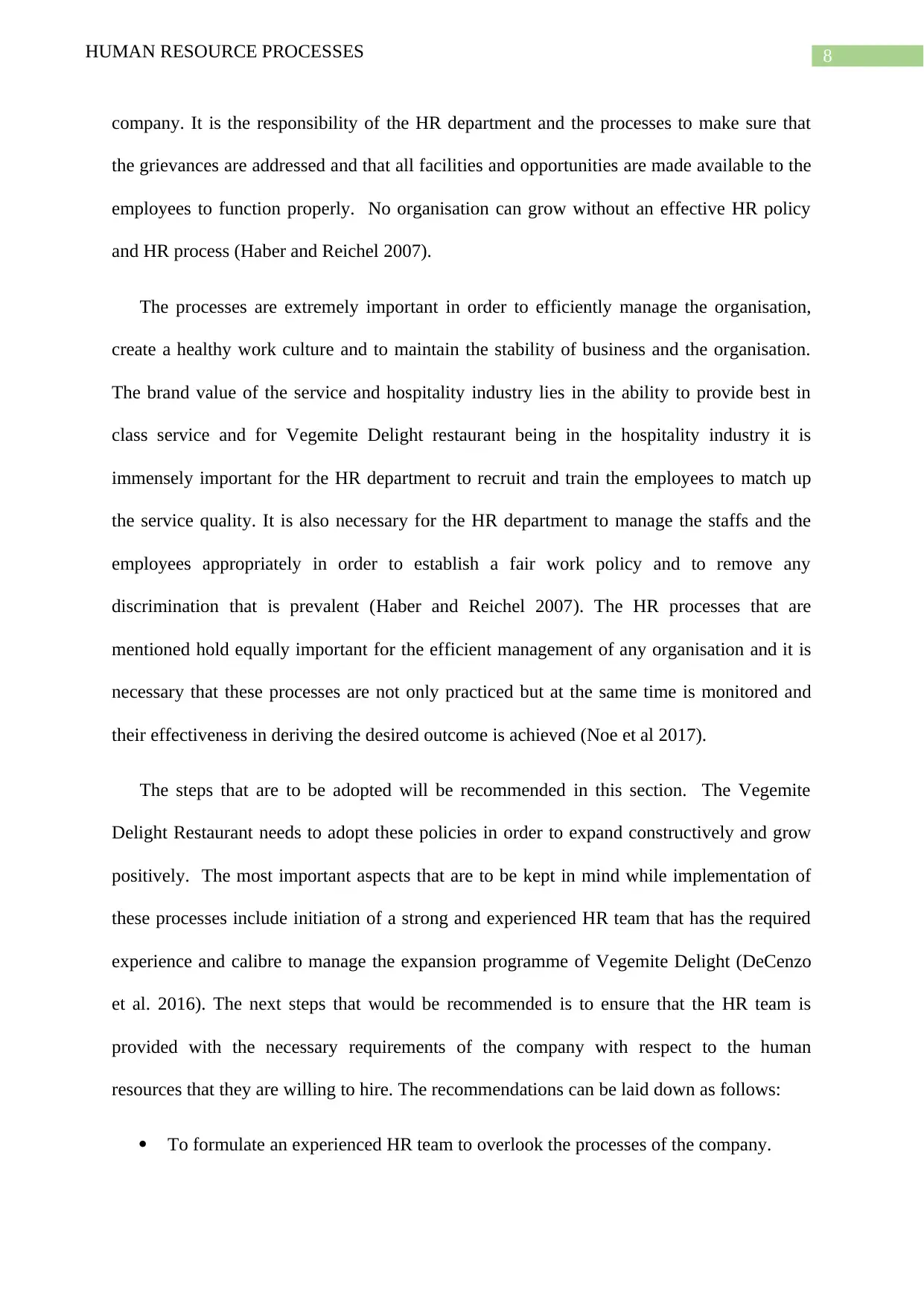
8HUMAN RESOURCE PROCESSES
company. It is the responsibility of the HR department and the processes to make sure that
the grievances are addressed and that all facilities and opportunities are made available to the
employees to function properly. No organisation can grow without an effective HR policy
and HR process (Haber and Reichel 2007).
The processes are extremely important in order to efficiently manage the organisation,
create a healthy work culture and to maintain the stability of business and the organisation.
The brand value of the service and hospitality industry lies in the ability to provide best in
class service and for Vegemite Delight restaurant being in the hospitality industry it is
immensely important for the HR department to recruit and train the employees to match up
the service quality. It is also necessary for the HR department to manage the staffs and the
employees appropriately in order to establish a fair work policy and to remove any
discrimination that is prevalent (Haber and Reichel 2007). The HR processes that are
mentioned hold equally important for the efficient management of any organisation and it is
necessary that these processes are not only practiced but at the same time is monitored and
their effectiveness in deriving the desired outcome is achieved (Noe et al 2017).
The steps that are to be adopted will be recommended in this section. The Vegemite
Delight Restaurant needs to adopt these policies in order to expand constructively and grow
positively. The most important aspects that are to be kept in mind while implementation of
these processes include initiation of a strong and experienced HR team that has the required
experience and calibre to manage the expansion programme of Vegemite Delight (DeCenzo
et al. 2016). The next steps that would be recommended is to ensure that the HR team is
provided with the necessary requirements of the company with respect to the human
resources that they are willing to hire. The recommendations can be laid down as follows:
To formulate an experienced HR team to overlook the processes of the company.
company. It is the responsibility of the HR department and the processes to make sure that
the grievances are addressed and that all facilities and opportunities are made available to the
employees to function properly. No organisation can grow without an effective HR policy
and HR process (Haber and Reichel 2007).
The processes are extremely important in order to efficiently manage the organisation,
create a healthy work culture and to maintain the stability of business and the organisation.
The brand value of the service and hospitality industry lies in the ability to provide best in
class service and for Vegemite Delight restaurant being in the hospitality industry it is
immensely important for the HR department to recruit and train the employees to match up
the service quality. It is also necessary for the HR department to manage the staffs and the
employees appropriately in order to establish a fair work policy and to remove any
discrimination that is prevalent (Haber and Reichel 2007). The HR processes that are
mentioned hold equally important for the efficient management of any organisation and it is
necessary that these processes are not only practiced but at the same time is monitored and
their effectiveness in deriving the desired outcome is achieved (Noe et al 2017).
The steps that are to be adopted will be recommended in this section. The Vegemite
Delight Restaurant needs to adopt these policies in order to expand constructively and grow
positively. The most important aspects that are to be kept in mind while implementation of
these processes include initiation of a strong and experienced HR team that has the required
experience and calibre to manage the expansion programme of Vegemite Delight (DeCenzo
et al. 2016). The next steps that would be recommended is to ensure that the HR team is
provided with the necessary requirements of the company with respect to the human
resources that they are willing to hire. The recommendations can be laid down as follows:
To formulate an experienced HR team to overlook the processes of the company.
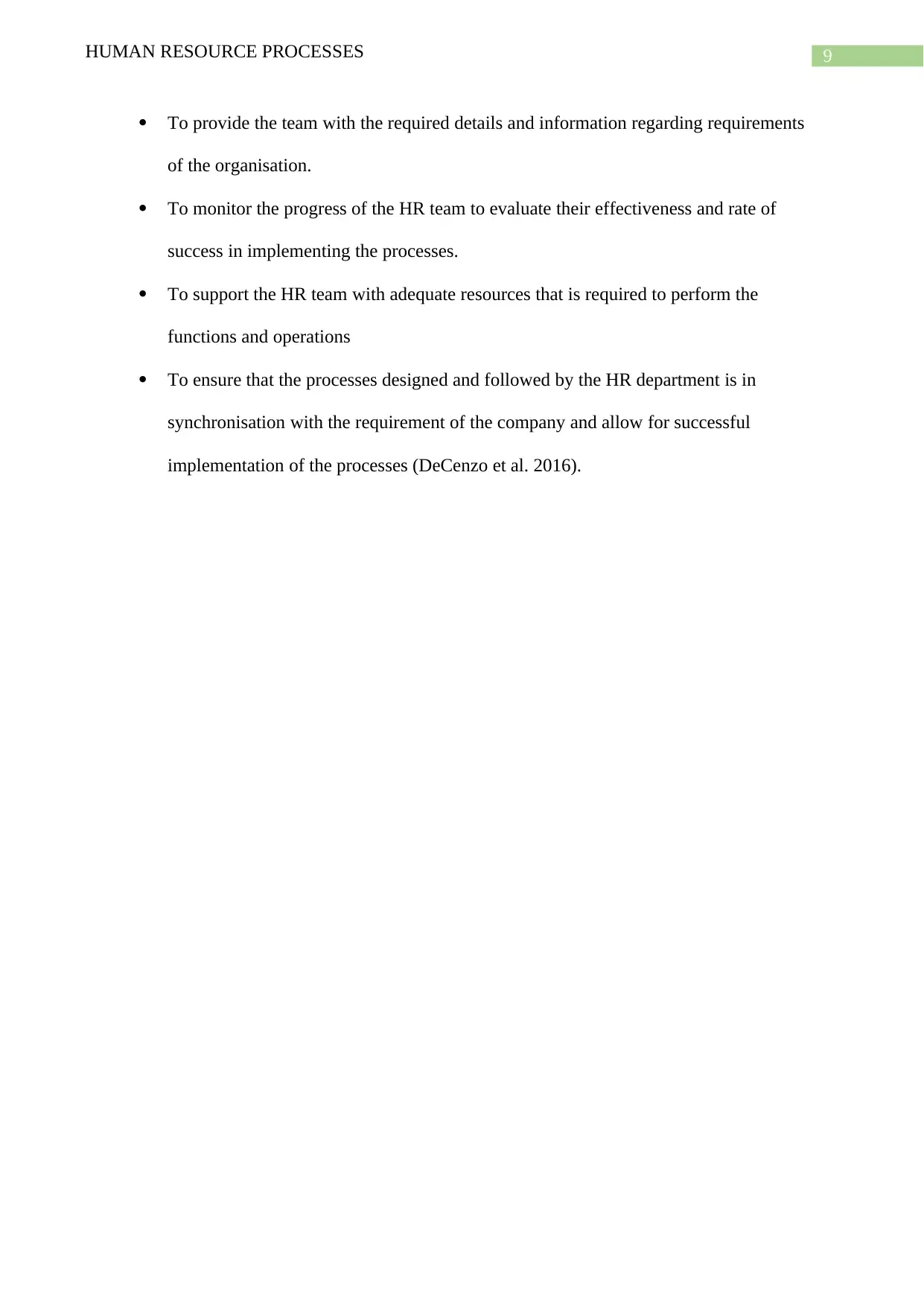
9HUMAN RESOURCE PROCESSES
To provide the team with the required details and information regarding requirements
of the organisation.
To monitor the progress of the HR team to evaluate their effectiveness and rate of
success in implementing the processes.
To support the HR team with adequate resources that is required to perform the
functions and operations
To ensure that the processes designed and followed by the HR department is in
synchronisation with the requirement of the company and allow for successful
implementation of the processes (DeCenzo et al. 2016).
To provide the team with the required details and information regarding requirements
of the organisation.
To monitor the progress of the HR team to evaluate their effectiveness and rate of
success in implementing the processes.
To support the HR team with adequate resources that is required to perform the
functions and operations
To ensure that the processes designed and followed by the HR department is in
synchronisation with the requirement of the company and allow for successful
implementation of the processes (DeCenzo et al. 2016).
⊘ This is a preview!⊘
Do you want full access?
Subscribe today to unlock all pages.

Trusted by 1+ million students worldwide
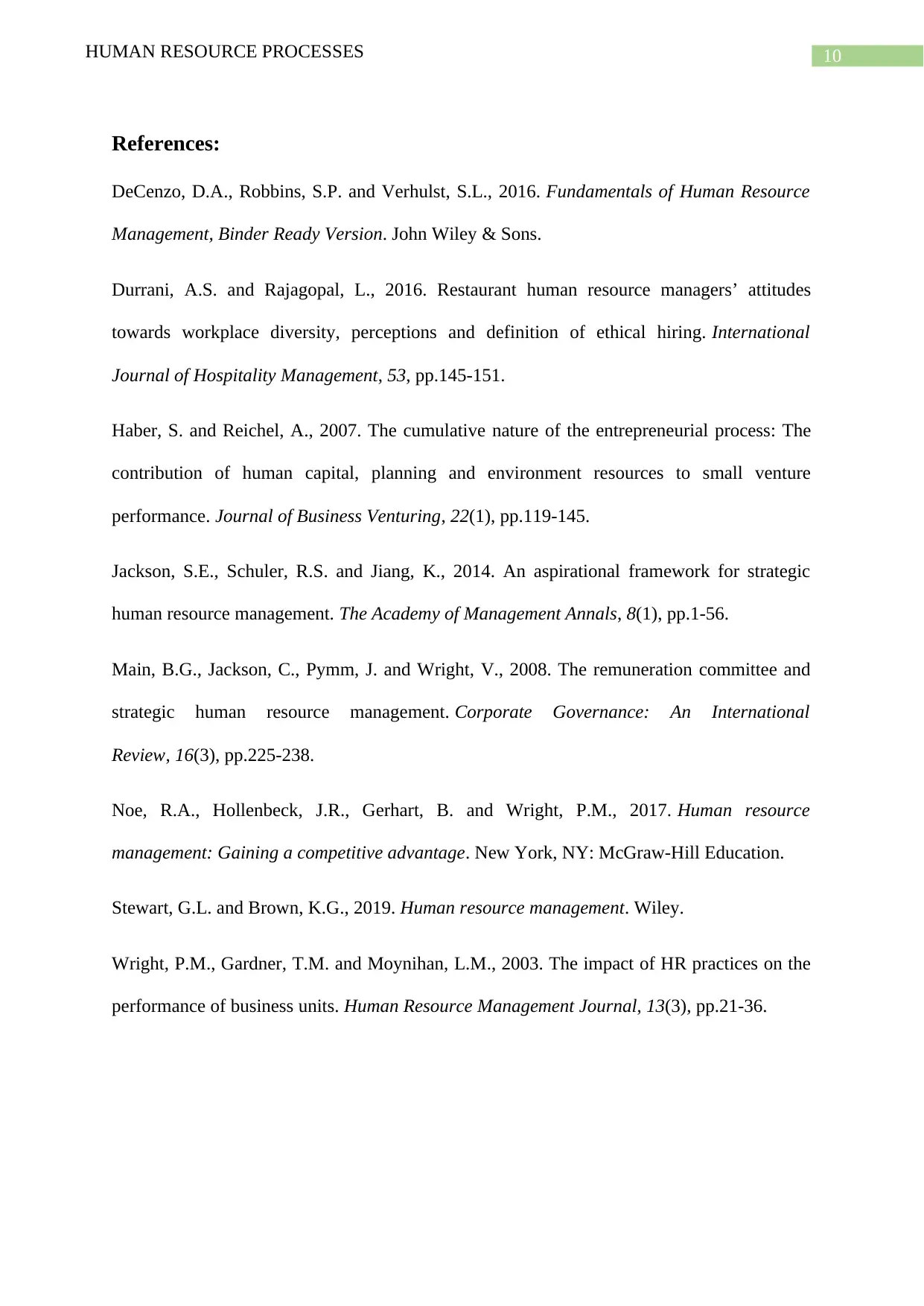
10HUMAN RESOURCE PROCESSES
References:
DeCenzo, D.A., Robbins, S.P. and Verhulst, S.L., 2016. Fundamentals of Human Resource
Management, Binder Ready Version. John Wiley & Sons.
Durrani, A.S. and Rajagopal, L., 2016. Restaurant human resource managers’ attitudes
towards workplace diversity, perceptions and definition of ethical hiring. International
Journal of Hospitality Management, 53, pp.145-151.
Haber, S. and Reichel, A., 2007. The cumulative nature of the entrepreneurial process: The
contribution of human capital, planning and environment resources to small venture
performance. Journal of Business Venturing, 22(1), pp.119-145.
Jackson, S.E., Schuler, R.S. and Jiang, K., 2014. An aspirational framework for strategic
human resource management. The Academy of Management Annals, 8(1), pp.1-56.
Main, B.G., Jackson, C., Pymm, J. and Wright, V., 2008. The remuneration committee and
strategic human resource management. Corporate Governance: An International
Review, 16(3), pp.225-238.
Noe, R.A., Hollenbeck, J.R., Gerhart, B. and Wright, P.M., 2017. Human resource
management: Gaining a competitive advantage. New York, NY: McGraw-Hill Education.
Stewart, G.L. and Brown, K.G., 2019. Human resource management. Wiley.
Wright, P.M., Gardner, T.M. and Moynihan, L.M., 2003. The impact of HR practices on the
performance of business units. Human Resource Management Journal, 13(3), pp.21-36.
References:
DeCenzo, D.A., Robbins, S.P. and Verhulst, S.L., 2016. Fundamentals of Human Resource
Management, Binder Ready Version. John Wiley & Sons.
Durrani, A.S. and Rajagopal, L., 2016. Restaurant human resource managers’ attitudes
towards workplace diversity, perceptions and definition of ethical hiring. International
Journal of Hospitality Management, 53, pp.145-151.
Haber, S. and Reichel, A., 2007. The cumulative nature of the entrepreneurial process: The
contribution of human capital, planning and environment resources to small venture
performance. Journal of Business Venturing, 22(1), pp.119-145.
Jackson, S.E., Schuler, R.S. and Jiang, K., 2014. An aspirational framework for strategic
human resource management. The Academy of Management Annals, 8(1), pp.1-56.
Main, B.G., Jackson, C., Pymm, J. and Wright, V., 2008. The remuneration committee and
strategic human resource management. Corporate Governance: An International
Review, 16(3), pp.225-238.
Noe, R.A., Hollenbeck, J.R., Gerhart, B. and Wright, P.M., 2017. Human resource
management: Gaining a competitive advantage. New York, NY: McGraw-Hill Education.
Stewart, G.L. and Brown, K.G., 2019. Human resource management. Wiley.
Wright, P.M., Gardner, T.M. and Moynihan, L.M., 2003. The impact of HR practices on the
performance of business units. Human Resource Management Journal, 13(3), pp.21-36.
Paraphrase This Document
Need a fresh take? Get an instant paraphrase of this document with our AI Paraphraser

11HUMAN RESOURCE PROCESSES
1 out of 11
Related Documents
Your All-in-One AI-Powered Toolkit for Academic Success.
+13062052269
info@desklib.com
Available 24*7 on WhatsApp / Email
![[object Object]](/_next/static/media/star-bottom.7253800d.svg)
Unlock your academic potential
Copyright © 2020–2025 A2Z Services. All Rights Reserved. Developed and managed by ZUCOL.




